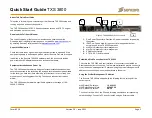
IGNITION NOISE INTERFERENCE
Use of a mobile receiver at low signal levels is normally limited by the
presence of electrical noise. The primary source of noise in automobile installations
is from the generator and ignition system in the vehicle. Under most operating
conditions, when signal level is adequate, the background noise does not present a
serious problem. Also, when extremely low level signals are being received, the
transceiver may be operated with vehicle engine turned off. The unit requires very
little current and therefore will not significantly discharge the vehicle battery.
Even though the transceiver has ANL and NB controls, in same installations
ignition interference may be high enough to make good communications
impossible. The electrical noise may come from several sources. Many possibilities
exist and variations between vehicles require different solutions to reduce the noise.
ANTENNA
A vertically polarized, quarter-wavelength whip antenna provides the most
reliable operation and greatest range. Shorter, loaded-type whip antennas are more
attractive, compact and adequate for applications where the maximum possible
distance is not required. Also, the loaded whips do not present the problems of
height imposed by a full quarter-wavelength whip.
Mobile whip antennas utilize the metal body of the vehicle as a ground plane.
When mounted at a corner of the vehicle they are slightly directional, in the
direction of the body of the vehicle. For all practical purpose, however, the
radiation pattern is nondirectional. The slight directional characteristic will be
observed only at extreme distance. A standard antenna connector (type SO239) is
provided on the transceiver for easy connection to a standard PL 259 cable
termination.
If the transceiver is not mounted on a metal surface, it is necessary to run a
separate ground wire from the unit to a good metal electrical ground in the vehicle.
When installed in a boat, the transceiver will not operate at maximum efficiency
without a ground plate, unless the vessel has a steel hull.
Before installing the transceiver in a boat, consult your dealer for information
regarding an adequate grounding system and prevention of electrolysis between
fittings in the hull and water.
TUNNING THE ANTENNA FOR OPTIMUM SWR
Since there is such a wide variety of base and mobile antennas, this
section will strictly concern itself to the various types of mobile adjustable
antennas. Because the antenna length is directly related to the channel frequency, it
must be tuned to resonate optimally all 40 channels of the transceiver. Channel 1
requires a longer antenna than Channel 40 because it is lower in frequency. Due to
the various methods of adjusting antennas for proper SWR we have chosen what
we think is the optimum method:
A. Antennas with adjustment screws (set screws)
1. Start with the antenna extended and tightens the set screw lightly enough so
that the antenna can be lightly tapped with your finger for easy adjustment.
2. Set your transceiver to Channel 21. @ Low band D or Hi band A. Press the
PTT (push-to-talk) switch, and tap the antenna (making it shorter). The SWR
meter will show a lower reading each time the antenna is tapped. By
continuing to shorten the antenna you will notice the SWR reading will reach a
low print and then start riding again. This means that you have passed the
optimum point for Channel 21. Extend the antenna a short distance and again
follow the procedure above.
When the lowest point has been reached, switch to Channel 1 @ Low band A
or Hi band E and then to Channel 40 @ Low band D or Hi band H and
compare SWR readings. They should be almost equal.
B. Antennas which must be cut to proper length.
1. Follow the same procedure as above, but adjust the length by cutting in 1/8”
increments until a good match is obtained.
2. Be very careful not to cut too much at one time, as one it is cut, it can no
longer be lengthed.
3. The whip is easily cut by filing a notch all the way around and breaking the
piece off with pliers.
If you are having difficulties in adjusting your antenna, check the following:
A. All doors must be closed when adjusting the antenna.
B. Make sure the antenna base is grounded.
C. Check your coaxial cable routing (it may be pinched when routed into the
car).
THE PROPER SETTING IS ACHIEVED WHEN THE SWR IS
1.5 OR BELOW, AND WHEN IT HAS THE SAME READING
FOR CHANNELS LOW BAND A1 AND HI BAND D40.
NOTE
- 5 -
- 6 -


























